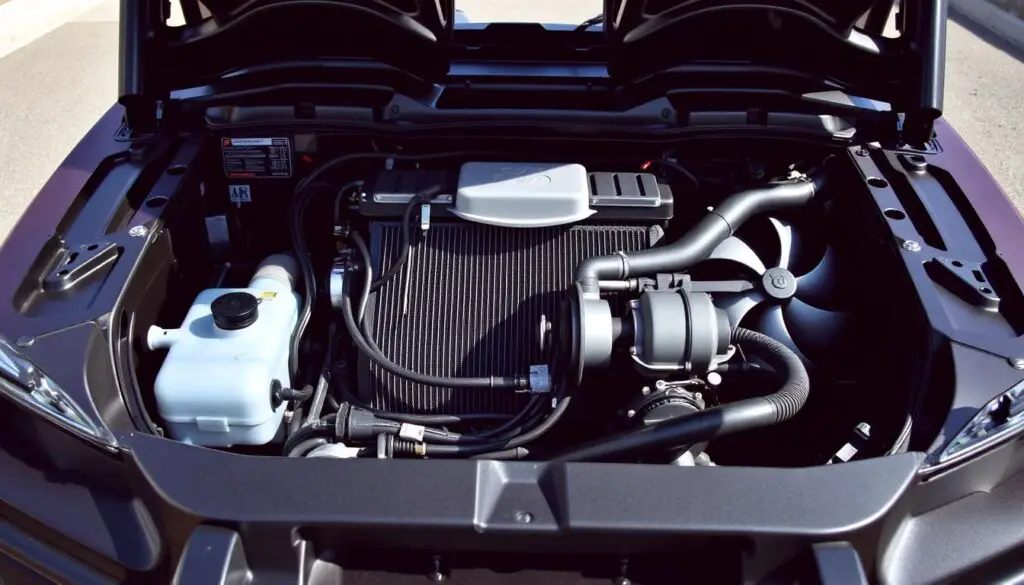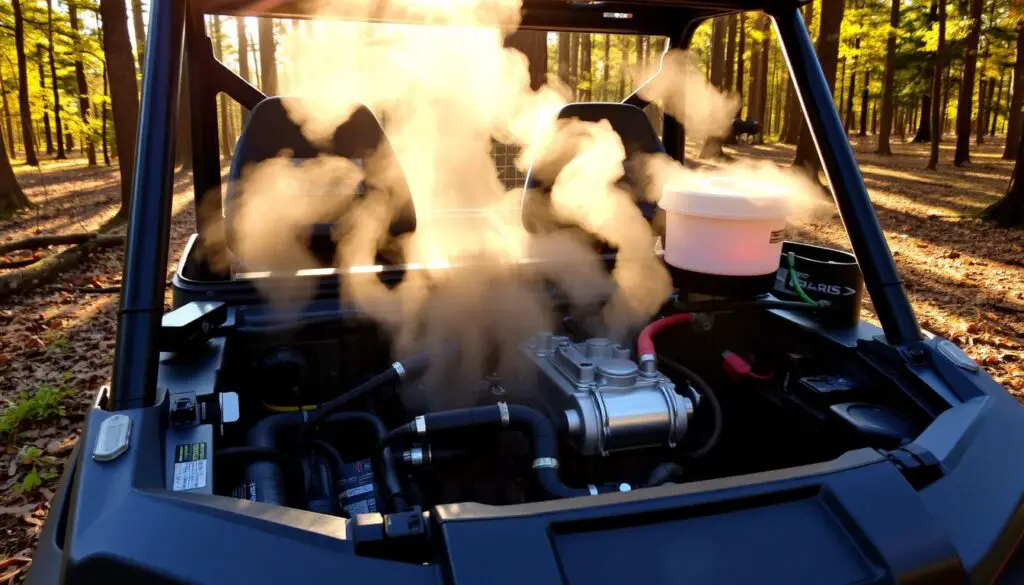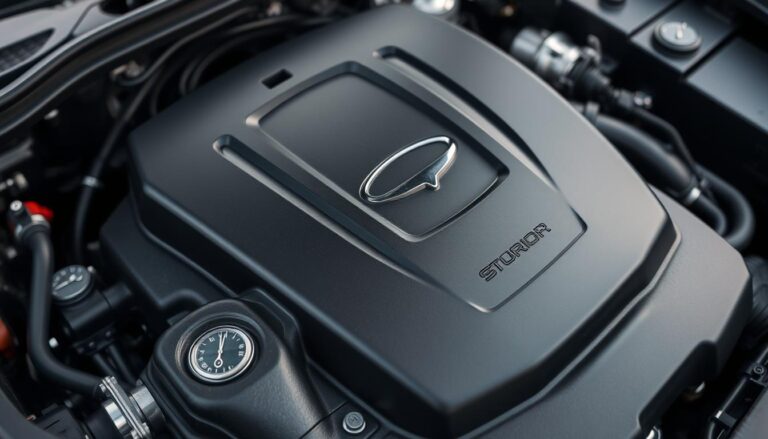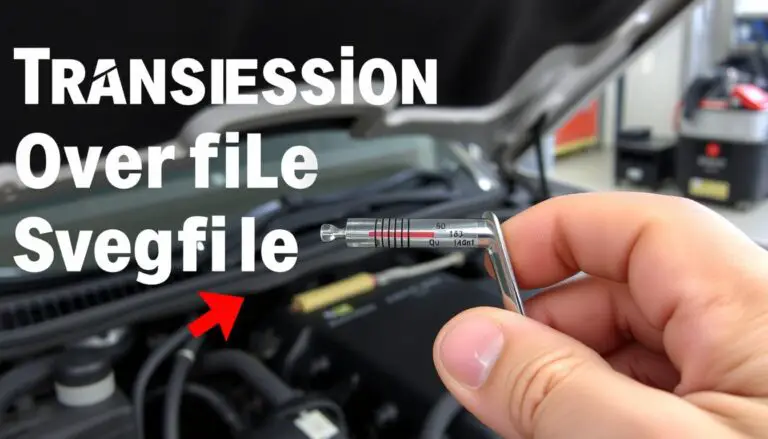The Polaris Ranger is a popular UTV known for its durability and performance. However, it can be prone to overheating issues if not properly maintained.
Understanding the UTV cooling system and its components is crucial to preventing overheating. Regular maintenance is key to keeping your vehicle running smoothly.
By exploring the common signs of overheating and how to diagnose and fix problems, you can ensure your Polaris Ranger remains in top condition.
Key Takeaways
- Regular maintenance is crucial to preventing overheating issues.
- Understanding the UTV cooling system is essential for optimal performance.
- Common signs of overheating should be identified and addressed promptly.
- Proper diagnosis and repair can help prevent further damage.
- Keeping your Polaris Ranger in top condition requires ongoing maintenance.
Understanding Your Polaris Ranger Cooling System
Understanding the intricacies of your Polaris Ranger’s cooling system is crucial for preventing overheating issues. The cooling system is designed to regulate engine temperature, ensuring optimal performance and longevity.
How the Cooling System Works
The Polaris Ranger cooling system operates by circulating coolant through the engine, absorbing heat, and dissipating it through the radiator. This process is facilitated by several key components working in harmony.

Key Components and Their Functions
The efficiency of the cooling system relies on the proper functioning of its components.
Radiator and Coolant
The radiator is responsible for dissipating heat from the coolant. The coolant itself plays a crucial role in absorbing heat from the engine and transferring it to the radiator. Using the correct type of coolant is vital for the system’s efficiency.
Water Pump and Thermostat
The water pump circulates coolant through the engine, while the thermostat regulates engine temperature by controlling coolant flow. A malfunctioning thermostat can lead to overheating.
Cooling Fans and Sensors
Cooling fans provide additional cooling when necessary, especially during low-speed operations or when the vehicle is stationary. Sensors monitor the engine temperature, alerting the driver to potential issues.
As emphasized by industry experts, “Regular maintenance of the cooling system is key to preventing overheating and ensuring the longevity of your Polaris Ranger.”
Common Signs of Polaris Ranger Overheating
Identifying the signs of overheating in your Polaris Ranger is crucial for preventing engine damage. Being aware of these indicators can help you take prompt action, potentially saving you from costly repairs down the line.
Dashboard Warning Indicators
Your Polaris Ranger’s dashboard is equipped with warning indicators that can alert you to potential overheating issues. Keep an eye on the temperature gauge and watch for warning lights that may illuminate when the engine is running too hot. As noted in an article on tackling ATV overheating, monitoring these indicators is a crucial step in maintaining your vehicle’s health.
Performance Issues Related to Overheating
Overheating can lead to a decrease in your Polaris Ranger’s performance. You might notice reduced power or sluggish acceleration, which can be indicative of an overheating engine. If you observe these symptoms, it’s essential to investigate the cause promptly.
Physical Signs to Watch For
Physical signs such as coolant leaks or excessive heat emanating from the engine are clear indicators of overheating. Regularly inspect your vehicle for these signs and address them immediately to prevent further damage. 
Polaris Ranger Overheating: Causes, Solutions, and Maintenance Tips
Understanding the causes of overheating in your Polaris Ranger is crucial for maintaining its performance and longevity. Various factors can contribute to overheating, and addressing these issues promptly can help prevent damage.
Coolant Issues
Coolant issues are a common cause of overheating in the Polaris Ranger. Leaks, low coolant levels, and using the wrong type of coolant can compromise the cooling system. Regularly check the coolant level and condition to ensure it’s functioning correctly. For more information on tackling ATV overheating, you can visit this helpful resource.
Radiator Problems
The radiator plays a vital role in dissipating heat from the coolant. Clogs and damage to the radiator can impede this process, leading to overheating. Regular inspection and maintenance of the radiator are essential to prevent such issues.
Fan Malfunctions
The cooling fan is another critical component of the cooling system. If the fan is not working correctly, it can lead to overheating, especially during low-speed operations or when the vehicle is stationary. Ensuring the fan is functioning properly is vital.
Thermostat Failures
A faulty thermostat can prevent the coolant from circulating properly, leading to overheating. The thermostat should be inspected regularly and replaced if necessary to maintain optimal engine temperature.
Water Pump Complications
The water pump is responsible for circulating coolant through the engine. Failures or inefficiencies in the water pump can lead to inadequate cooling, resulting in overheating. Regular maintenance and inspection of the water pump are crucial.
By understanding and addressing these common causes of overheating, Polaris Ranger owners can take proactive steps to maintain their vehicle’s performance and prevent costly repairs.
Operating Conditions That Contribute to Overheating
Several operating conditions can contribute to overheating in your Polaris Ranger, including heavy loads and extreme weather. Being aware of these factors can help you take preventive measures.
Heavy Loads and Towing
Towing or carrying heavy loads puts additional strain on your Polaris Ranger’s engine, increasing the risk of overheating. It’s essential to monitor your vehicle’s temperature gauge when operating under such conditions.
Extreme Weather Conditions
Operating your Polaris Ranger in extreme temperatures or high humidity can exacerbate cooling system demands. Ensure your cooling system is in good condition before heading into challenging weather.
Dusty or Muddy Terrain
Dusty or muddy conditions can compromise your vehicle’s cooling system performance. Regularly check and clean your radiator and other components to prevent clogs.
Extended Idle Time
Extended idling can cause your engine to heat up, further increasing the risk of overheating. Try to minimize idle times and ensure proper airflow around the engine.
By understanding and managing these operating conditions, you can significantly reduce the risk of overheating and maintain your Polaris Ranger’s performance.
Diagnosing Overheating Problems in Your UTV
When your Polaris Ranger starts to overheat, a systematic diagnostic approach can help identify the root cause. Diagnosing overheating issues requires a combination of basic diagnostic steps, the right tools, and a methodical troubleshooting plan.
Basic Diagnostic Steps
Begin by checking the coolant level to ensure it’s at the recommended level. Inspect the radiator for any signs of damage or corrosion. Look for leaks in the cooling system, and check the condition of the coolant.
Tools Needed for Proper Diagnosis
Having the right diagnostic tools is essential. A multimeter can help you test electrical components, while a pressure tester can identify leaks in the cooling system. Other useful tools include a thermometer to check the temperature and a inspection light for a thorough examination.
Creating a Systematic Troubleshooting Plan
Create a step-by-step plan to isolate the cause of the overheating issue. Start with the simplest potential causes, such as low coolant levels, and gradually move on to more complex issues like thermostat or water pump failures.
When to Seek Professional Help
If you’re unsure about any aspect of the diagnosis or if the problem persists after your troubleshooting efforts, it’s time to seek professional help. A certified mechanic can provide a more detailed diagnosis and perform the necessary repairs.
Step-by-Step Solutions for Common Overheating Issues
Once you’ve identified the cause of overheating in your Polaris Ranger, implementing the right solutions is crucial for restoring optimal performance. The following step-by-step guide will help you address common overheating issues.
Coolant System Flush and Refill
A coolant system flush and refill is a straightforward process that can significantly improve your Polaris Ranger’s cooling performance. This involves several key steps:
Draining the Old Coolant
Begin by draining the old coolant from the system. Locate the drain valve and allow the coolant to flow out completely. Be sure to capture the coolant in a suitable container for proper disposal.
Selecting the Right Coolant
Choosing the correct coolant is vital for the longevity of your Polaris Ranger’s engine. Refer to your owner’s manual for the recommended coolant type. Using the wrong coolant can lead to compatibility issues and potentially damage your engine.
Proper Filling Techniques
After flushing the system, refill it with the new coolant. Ensure that you follow the manufacturer’s guidelines for the correct filling procedure to avoid air pockets in the system.
Radiator Cleaning and Repair
The radiator is a critical component of your Polaris Ranger’s cooling system. Cleaning the radiator involves removing any debris or sediment that may be causing clogs. Inspect the radiator for any signs of damage and perform repairs as needed.
Fan and Thermostat Replacement
If your Polaris Ranger’s fan or thermostat is malfunctioning, replacing these components can resolve overheating issues. Ensure that you source replacement parts that are compatible with your vehicle.
Water Pump Inspection and Service
The water pump plays a crucial role in circulating coolant through your Polaris Ranger’s engine. Inspect the water pump for signs of wear or leakage. Service or replace the water pump as necessary to maintain optimal cooling performance.
By following these step-by-step solutions, you can effectively address common overheating issues in your Polaris Ranger and ensure it continues to run smoothly.
Preventative Maintenance to Avoid Overheating
Preventative maintenance is the key to avoiding overheating issues in your Polaris Ranger. By regularly checking and maintaining your vehicle’s cooling system, you can identify potential problems before they become major issues.
Regular Cooling System Checks
Regular checks of your Polaris Ranger’s cooling system are essential. This includes inspecting the coolant level, checking for leaks, and ensuring the radiator is clean and free of debris. It’s recommended to check the coolant level at least once a month and top it off as necessary.
Seasonal Maintenance Tips
Seasonal maintenance is crucial for optimal performance. Different seasons bring different challenges for your Polaris Ranger’s cooling system.
Summer Preparation
Before summer, inspect your cooling system thoroughly. Check the coolant’s condition and concentration. Ensure the radiator is clean and the fan is working correctly. Consider using a higher concentration of coolant if you’re operating in extremely hot conditions.
Winter Considerations
In winter, ensure your coolant is suitable for cold temperatures. Check for any signs of leakage and ensure the thermostat is functioning correctly. Using the wrong type of coolant can lead to freezing and damage to your cooling system.
Proper Riding Habits to Reduce Heat Stress
Avoiding heavy loads and extended idle times can significantly reduce heat stress on your Polaris Ranger’s engine. Try to maintain a steady speed when driving, and avoid sudden accelerations.
Maintenance Schedule for Optimal Performance
Following a regular maintenance schedule is vital. This includes regular checks of the cooling system, fan, and thermostat. Refer to your owner’s manual for the recommended maintenance schedule.
| Maintenance Task | Frequency | Importance |
|---|---|---|
| Coolant Level Check | Monthly | High |
| Cooling System Inspection | Every 6 months | High |
| Radiator Cleaning | Annually | Medium |
| Thermostat Check | Every 12 months | High |
By following these preventative maintenance tips, you can significantly reduce the risk of overheating and ensure your Polaris Ranger runs smoothly.
Conclusion
Maintaining your Polaris Ranger’s cooling system is crucial to preventing overheating issues. By understanding the causes, recognizing the signs, and taking corrective action, you can ensure optimal performance and extend the lifespan of your UTV.
Regular maintenance, including cooling system checks and seasonal preparation, plays a significant role in preventing overheating. For more information on maintaining other critical components, such as your vehicle’s alternator, visit Automotive Simple to learn about common issues and solutions.
A well-maintained Polaris Ranger provides years of reliable service. By following the guidelines outlined in this article, you can enjoy a trouble-free ownership experience and maximize your UTV’s performance.
FAQ
What are the common signs of Polaris Ranger overheating?
Common signs include dashboard warning indicators, performance issues like reduced power or sluggish acceleration, and physical signs such as coolant leaks or excessive heat emanating from the engine.
How does the cooling system in my Polaris Ranger work?
The cooling system regulates engine temperature through components like the radiator, coolant, water pump, thermostat, cooling fans, and sensors, working together to dissipate heat and maintain optimal engine temperature.
What causes overheating in a Polaris Ranger?
Causes include coolant issues like leaks or low levels, radiator problems such as clogs or damage, fan malfunctions, thermostat failures, and water pump complications.
How can I diagnose overheating problems in my Polaris Ranger?
Diagnosing overheating involves basic steps like checking coolant levels, inspecting the radiator, and using tools like a multimeter and pressure tester to identify the cause, and creating a systematic troubleshooting plan.
What are some preventative maintenance tips to avoid overheating?
Regular cooling system checks, seasonal maintenance like preparing for summer or winter, practicing proper riding habits, and following a maintenance schedule can help prevent overheating issues.
How do I perform a coolant system flush and refill?
Flushing and refilling involves draining the old coolant, selecting the right coolant, and using proper filling techniques to restore optimal cooling performance.
What operating conditions can contribute to overheating?
Heavy loads, towing, extreme weather, dusty or muddy terrain, and extended idle times can increase the risk of overheating in your Polaris Ranger.
How often should I check my Polaris Ranger’s cooling system?
Regular checks should be performed as part of a maintenance schedule to identify potential issues before they become major problems.
Can I replace the thermostat or fans myself?
Yes, replacing faulty thermostats or fans can be done by following step-by-step guides, but it’s essential to ensure proper installation to maintain optimal performance.
What are the benefits of regular maintenance for my Polaris Ranger?
Regular maintenance can help prevent overheating issues, ensure optimal performance, and contribute to a trouble-free ownership experience.


